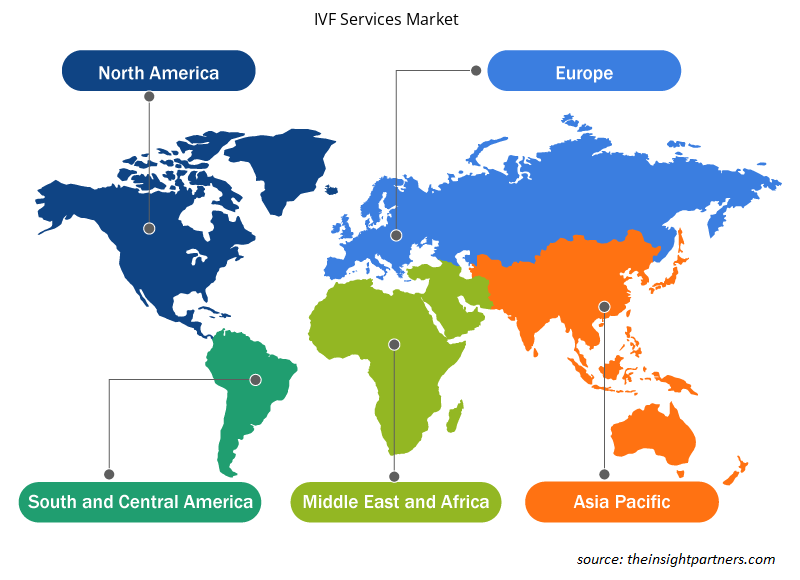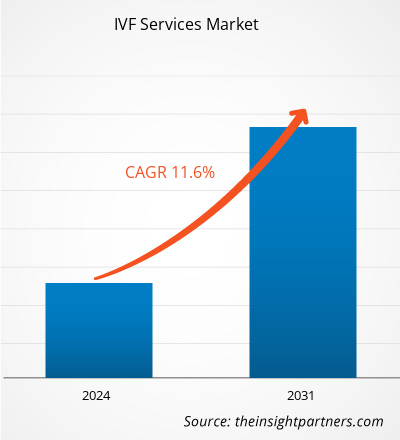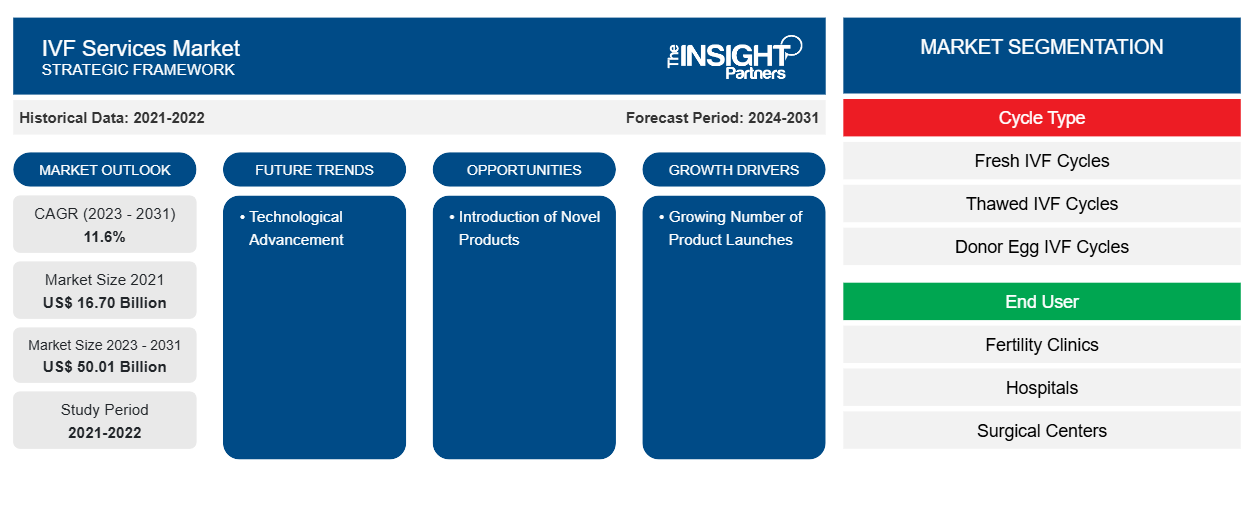Si stima che le dimensioni del mercato dei servizi di fecondazione in vitro siano state di 16,70 miliardi di dollari USA nel 2021 e di XX milioni di dollari USA nel 2023 e si prevede che raggiungeranno i 50,01 miliardi di dollari USA entro il 2031. Si stima che registrerà un CAGR dell'11,6% fino al 2031. L'aumento dell'incidenza dell'infertilità, il crescente numero di cliniche per la fertilità e servizi per l'infertilità con il supporto del governo e l'integrazione dell'intelligenza artificiale nella fecondazione in vitro rimarranno probabilmente le principali tendenze del mercato dei servizi di fecondazione in vitro .CAGR of 11.6% till 2031. Increasing incidences of infertility, rising number of fertility clinics and infertility services with government support, and integration of artificial intelligence in In vitro fertilization are likely to remain key IVF services
Analisi di mercato dei servizi di fecondazione in vitro
La fecondazione in vitro (FIV) è una terapia per la fertilità in cui gli ovuli vengono prelevati dalle ovaie delle donne e fecondati con lo sperma al di fuori del corpo. La procedura prevede diversi passaggi e può essere richiesta da coppie o individui che soffrono di problemi di fertilità. Attualmente, varie cliniche e centri per la fecondazione in vitro forniscono servizi di fecondazione in vitro in tutto il mondo.
Il tasso di fertilità sta diminuendo costantemente a livello globale, a causa di vari fattori, come la crescente inclinazione ai matrimoni tardivi e l'aumento dell'infertilità legata all'età . Si prevede che i tassi di fertilità globali scenderanno a 2,4 figli per donna entro il 2030 e a 2,2 figli per donna entro il 2050. Circa il 12% delle donne nella fascia di età compresa tra 15 e 44 anni negli Stati Uniti ha avuto difficoltà a rimanere incinta o a portare a termine la gravidanza, indipendentemente dallo stato civile. Inoltre, circa il 6,0% delle donne sposate di età compresa tra 15 e 44 anni negli Stati Uniti non è in grado di rimanere incinta dopo un anno di tentativi (infertilità). Pertanto, il calo del tasso di fertilità porta a un aumento sostanziale della domanda di servizi di fecondazione in vitro (FIV) che influenzano la finestra di fertilità negli uomini e nelle donne.
Panoramica del mercato dei servizi di fecondazione in vitro
L'incidenza crescente dell'infertilità, il numero crescente di cliniche per la fertilità e servizi per l'infertilità con supporto governativo e il numero crescente di lanci e sviluppi di prodotti. Tuttavia, l'elevato costo procedurale delle tecniche riproduttive e i rischi associati al trattamento dell'infertilità ostacolano la crescita del mercato. Il mercato globale dei servizi di fecondazione in vitro è segmentato per regione in Nord America, Europa, Asia Pacifico, Medio Oriente e Africa e Sud e Centro America. La regione europea detiene la quota di mercato maggiore, mentre la regione Asia Pacifico è la regione in più rapida crescita. Fattori come un aumento del trattamento dell'infertilità tramite fecondazione in vitro e ART. Il crescente supporto da parte del governo attraverso vari programmi, il numero crescente di centri per la fertilità nei paesi e il calo del tasso di fertilità tra le donne probabilmente aumenteranno la crescita del mercato nella regione durante gli anni previsti.
Personalizza questo report in base alle tue esigenze
Riceverai la personalizzazione gratuita di qualsiasi report, comprese parti di questo report, o analisi a livello nazionale, pacchetto dati Excel, oltre a usufruire di grandi offerte e sconti per start-up e università
-
Scopri le principali tendenze di mercato in questo rapporto.Questo campione GRATUITO includerà analisi di dati che spaziano dalle tendenze di mercato alle stime e alle previsioni.
Driver e opportunità del mercato dei servizi di fecondazione in vitro
Numero crescente di lanci di prodotti Sviluppo per favorire il mercato
Le aziende nel mercato dei servizi di fecondazione in vitro stanno adottando un comportamento di ricerca e sviluppo sempre più aggressivo per introdurre prodotti più innovativi. I nuovi cicli di fecondazione in vitro scongelati, i cicli di fecondazione in vitro con ovociti donati, i sistemi di micromanipolazione e le incubatrici stanno consentendo l'adozione di tecnologie cellulari avanzate, che stanno rafforzando i risultati procedurali. A gennaio 2021, Royal Philips, leader mondiale nella tecnologia sanitaria, ha dichiarato una partnership pluriennale con Merck, azienda leader in scienza e tecnologia, per sviluppare soluzioni digitali di livello clinico per trattamenti di fertilità altamente personalizzati. Si prevede che un numero crescente di lanci di prodotti, fusioni e acquisizioni e sviluppi guideranno il mercato dei servizi di fecondazione in vitro.behaviour to introduce more innovative products. The new thawed IVF cycles, donor egg IVF cycles, micromanipulator systems, and
Conduzione di campagne di sensibilizzazione – Un’opportunità inil mercato dei servizi di fecondazione in vitro
Le campagne di sensibilizzazione stanno contribuendo in modo sostanziale ad aumentare la portata delle tecnologie e delle terapie di fecondazione in vitro tra le popolazioni. Tali campagne hanno anche un potenziale considerevole per promuovere nuovi centri di fecondazione in vitro, lo scambio di informazioni e le discussioni. Ad esempio, la prima settimana di novembre 2022 è stata osservata come Settimana europea della fertilità 2022. La settimana è stata osservata per invitare i decisori politici in tutta Europa a migliorare l'accesso e la qualità dei trattamenti per l'infertilità esistenti. Inoltre, organizzazioni come Fertility Europe stanno adottando misure concrete per diffondere le informazioni corrette sui trattamenti per l'infertilità. Nel 2022, l'EFW dedicherà l'intera settimana a sensibilizzare sul percorso di fertilità del paziente e sulle difficoltà che spesso deve affrontare. Pertanto, si prevede che la conduzione di campagne di sensibilizzazione appropriate fornirà solide piattaforme di presentazione per le aziende, offrendo così opportunità di crescita per spingere i ricavi all'interno dell'ecosistema dinamico.EFW will dedicate the whole week to bringing awareness to the patient's fertility journey and the difficulties they often have to deal with. Thus, conduction of appropriate awareness campaigns is expected to provide robust showcasing platforms for companies, thereby offering growth opportunities to propel revenues within the dynamic ecosystem.
Analisi della segmentazione del rapporto di mercato sui servizi di fecondazione in vitro
I segmenti chiave che hanno contribuito alla derivazione dell'analisi di mercato dei servizi di fecondazione in vitro sono il tipo di ciclo e l'utente finale.
- In base al tipo di ciclo, il mercato dei servizi di fecondazione in vitro è suddiviso in cicli di fecondazione in vitro, cicli di fecondazione in vitro scongelati e cicli di fecondazione in vitro con ovociti donati. Il segmento dei cicli di fecondazione in vitro freschi ha detenuto la quota maggiore del mercato nel 2023; inoltre, si prevede che lo stesso segmento registrerà la più alta percentuale di CAGR nel mercato durante il periodo di previsione.
- In base agli utenti finali, il mercato è segmentato in ospedali, cliniche per la fertilità, centri chirurgici e istituti di ricerca clinica. Il segmento dei centri per la fertilità ha detenuto la quota maggiore del mercato nel 2023; inoltre, si prevede che il segmento registrerà il CAGR più elevato nel mercato nel periodo 2023-2031.
Analisi della quota di mercato dei servizi di fecondazione in vitro per area geografica
L'ambito geografico del rapporto di mercato dei servizi di fecondazione in vitro è principalmente suddiviso in cinque regioni: Nord America, Asia Pacifico, Europa, Medio Oriente e Africa e Sud America/Sud e Centro America. Il Nord America ha dominato il mercato dei servizi di fecondazione in vitro dopo l'Europa. C'è un aumento del tasso di trattamento dell'infertilità in tutto il paese. Sulla base del rapporto sui tassi di successo delle cliniche per la fertilità del CDC del 2018, sono stati eseguiti 306.197* cicli di procreazione assistita presso 456 cliniche segnalanti negli Stati Uniti nel 2018, con conseguenti 73.831 nati vivi (parti di uno o più neonati vivi) e 81.478 neonati vivi. Il Nord America ha detenuto la quota maggiore nel 2023. Un'inclinazione verso prodotti tecnicamente avanzati e la presenza di attori del mercato globale sono fattori che contribuiscono al predominio del mercato dei servizi di fecondazione in vitro nordamericano. Si prevede che l'Asia Pacifico crescerà con il CAGR più elevato nei prossimi anni.
Approfondimenti regionali sul mercato dei servizi di fecondazione in vitro
Le tendenze regionali e i fattori che influenzano il mercato dei servizi di fecondazione in vitro durante il periodo di previsione sono stati ampiamente spiegati dagli analisti di Insight Partners. Questa sezione discute anche i segmenti e la geografia del mercato dei servizi di fecondazione in vitro in Nord America, Europa, Asia Pacifico, Medio Oriente e Africa e America centrale e meridionale.

- Ottieni i dati specifici regionali per il mercato dei servizi di fecondazione in vitro
Ambito del rapporto sul mercato dei servizi di fecondazione in vitro
| Attributo del report | Dettagli |
|---|---|
| Dimensioni del mercato nel 2021 | 16,70 miliardi di dollari USA |
| Dimensioni del mercato entro il 2031 | 50,01 miliardi di dollari USA |
| CAGR globale (2023-2031) | 11,6% |
| Dati storici | 2021-2022 |
| Periodo di previsione | 2024-2031 |
| Segmenti coperti |
Per tipo di ciclo
|
| Regioni e Paesi coperti |
America del Nord
|
| Leader di mercato e profili aziendali chiave |
|
Densità degli attori del mercato: comprendere il suo impatto sulle dinamiche aziendali
Il mercato dei servizi di fecondazione in vitro sta crescendo rapidamente, spinto dalla crescente domanda degli utenti finali dovuta a fattori quali l'evoluzione delle preferenze dei consumatori, i progressi tecnologici e una maggiore consapevolezza dei benefici del prodotto. Con l'aumento della domanda, le aziende stanno ampliando le loro offerte, innovando per soddisfare le esigenze dei consumatori e capitalizzando sulle tendenze emergenti, il che alimenta ulteriormente la crescita del mercato.
La densità degli operatori di mercato si riferisce alla distribuzione di aziende o società che operano in un particolare mercato o settore. Indica quanti concorrenti (operatori di mercato) sono presenti in un dato spazio di mercato in relazione alle sue dimensioni o al valore di mercato totale.
Le principali aziende che operano nel mercato dei servizi di fecondazione in vitro sono:
- Assistenza sanitaria massima,
- Fioritura FIV,
- Fertilità CCRM,
- OXFORD FERTILITÀ,
- Creare Salute (Creare Fertilità),
- Medicover,
Disclaimer : le aziende elencate sopra non sono classificate secondo un ordine particolare.

- Ottieni una panoramica dei principali attori del mercato dei servizi di fecondazione in vitro
Notizie e sviluppi recenti sul mercato dei servizi di fecondazione in vitro
Il mercato dei servizi di fecondazione in vitro viene valutato raccogliendo dati qualitativi e quantitativi post-ricerca primaria e secondaria, che includono importanti pubblicazioni aziendali, dati di associazioni e database. Di seguito è riportato un elenco degli sviluppi nel mercato dei servizi di fecondazione in vitro e delle strategie:
- Ad aprile 2023, Cryoport, Inc., un fornitore leader a livello mondiale di soluzioni innovative per la supply chain a temperatura controllata per il settore delle scienze biologiche e leader nelle soluzioni per la supply chain per i mercati della medicina riproduttiva, ha annunciato un accordo pluriennale con Inception Fertility. Inception Fertility gestisce The Prelude Network® (Prelude), la più grande e in più rapida crescita rete di centri per la fertilità basata sulla tecnologia in Nord America. (Fonte: Prelude Fertility, comunicato stampa, 2024)
- Ad aprile 2023, The Prelude Network, un fornitore leader di servizi di fertilità completi in Nord America, ha annunciato una partnership esclusiva con Future Family (FF), una piattaforma nazionale per la creazione di famiglie con piani finanziari flessibili e servizi di supporto concierge. La partnership mira ad ampliare l'accessibilità finanziaria ai servizi di fertilità premium, offrendo ai pazienti più opzioni finanziarie e una chiara comprensione dei costi del trattamento. Fonte: (Prelude Fertility, comunicato stampa, 2024)
Copertura e risultati del rapporto sul mercato dei servizi di fecondazione in vitro
Il rapporto “Dimensioni e previsioni del mercato dei servizi di fecondazione in vitro (2021-2031)” fornisce un’analisi dettagliata del mercato che copre le seguenti aree:
- Dimensioni e previsioni del mercato a livello globale, regionale e nazionale per tutti i segmenti di mercato chiave coperti dall'ambito
- Dinamiche di mercato come fattori trainanti, vincoli e opportunità chiave
- Principali tendenze future
- Analisi dettagliata delle cinque forze PEST/Porter e SWOT
- Analisi di mercato globale e regionale che copre le principali tendenze di mercato, i principali attori, le normative e gli sviluppi recenti del mercato
- Analisi del panorama industriale e della concorrenza che copre la concentrazione del mercato, l'analisi della mappa di calore, i principali attori e gli sviluppi recenti
- Profili aziendali dettagliati
- Analisi storica (2 anni), anno base, previsione (7 anni) con CAGR
- Analisi PEST e SWOT
- Valore/volume delle dimensioni del mercato - Globale, Regionale, Nazionale
- Industria e panorama competitivo
- Set di dati Excel
Report recenti
Testimonianze
Motivo dell'acquisto
- Processo decisionale informato
- Comprensione delle dinamiche di mercato
- Analisi competitiva
- Analisi dei clienti
- Previsioni di mercato
- Mitigazione del rischio
- Pianificazione strategica
- Giustificazione degli investimenti
- Identificazione dei mercati emergenti
- Miglioramento delle strategie di marketing
- Aumento dell'efficienza operativa
- Allineamento alle tendenze normative























 Ottieni un campione gratuito per - Mercato dei servizi di fecondazione in vitro
Ottieni un campione gratuito per - Mercato dei servizi di fecondazione in vitro